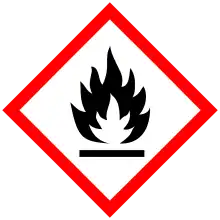 | |
| Names | |
|---|---|
| Other names
Aluminium sulfide | |
| Identifiers | |
| |
3D model (JSmol) |
|
| ChemSpider | |
| ECHA InfoCard | 100.013.736 |
| EC Number |
|
PubChem CID |
|
| UNII | |
CompTox Dashboard (EPA) |
|
| |
| |
| Properties | |
| Al2S3 | |
| Molar mass | 150.158 g/mol |
| Appearance | gray solid |
| Density | 2.02 g/cm3 |
| Melting point | 1,100 °C (2,010 °F; 1,370 K) |
| Boiling point | 1,500 °C (2,730 °F; 1,770 K) sublimes |
| decomposes | |
| Solubility | insoluble in acetone |
| Structure | |
| trigonal | |
| Thermochemistry | |
Heat capacity (C) |
105.1 J/mol K |
Std molar entropy (S⦵298) |
116.9 J/mol K |
Std enthalpy of formation (ΔfH⦵298) |
-724 kJ/mol |
| Hazards | |
| GHS labelling: | |
  | |
| Danger | |
| NFPA 704 (fire diamond) | |
| Safety data sheet (SDS) | |
Except where otherwise noted, data are given for materials in their standard state (at 25 °C [77 °F], 100 kPa).
Infobox references | |
Aluminium sulfide is a chemical compound with the formula Al2S3. This colorless species has an interesting structural chemistry, existing in several forms. The material is sensitive to moisture, hydrolyzing to hydrated aluminum oxides/hydroxides.[1] This can begin when the sulfide is exposed to the atmosphere. The hydrolysis reaction generates gaseous hydrogen sulfide (H2S).
Crystal structure
More than six crystalline forms of aluminium sulfide are known and only some are listed below. Most of them have rather similar, wurtzite-like structures, and differ by the arrangement of lattice vacancies, which form ordered or disordered sublattices.[2][3]
| Form | Symmetry | Space group | a (A) | c (A) | ρ (g/cm3) |
|---|---|---|---|---|---|
| α | Hexagonal | P61 | 6.423 | 17.83 | 2.32 |
| β | Hexagonal | P63mc | 3.579 | 5.829 | 2.495 |
| γ | Trigonal | 6.47 | 17.26 | 2.36 | |
| δ | Tetragonal | I41/amd | 7.026 | 29.819 | 2.71 |
The β and γ phases are obtained by annealing the most stable α-Al2S3 phase at several hundred degrees Celsius.[4] Compressing aluminium sulfide to 2–65 bar results in the δ phase where vacancies are arranged in a superlattice of tetragonal symmetry.[5]
Unlike Al2O3, in which the Al(III) centers occupy octahedral holes, the more expanded framework of Al2S3 stabilizes the Al(III) centers into one third of the tetrahedral holes of a hexagonally close-packed arrangement of the sulfide anions. At higher temperature, the Al(III) centers become randomized to give a "defect wurtzite" structure. And at still higher temperatures stabilize the γ-Al2S3 forms, with a structure akin to γ-Al2O3.
Molecular derivatives of Al2S3 are not known. Mixed Al-S-Cl compounds are however known. Al2Se3 and Al2Te3 are also known.
Preparation
Aluminium sulfide is readily prepared by ignition of the elements[6]
- 2 Al + 3 S → Al2S3
This reaction is extremely exothermic and it is not necessary or desirable to heat the whole mass of the sulfur-aluminium mixture; (except possibly for very small amounts of reactants). The product will be created in a fused form; it reaches a temperature greater than 1100 °C and may melt its way through steel. The cooled product is very hard.
References
- ↑ Holleman, A. F.; Wiberg, E. "Inorganic Chemistry" Academic Press: San Diego, 2001. ISBN 0-12-352651-5.
- ↑ Hans Landolt; D. Bimberg, Richard Börnstein; Richard Börnstein (1982). Halbleiter. Springer. pp. 12–. ISBN 978-3-540-13507-4. Retrieved 23 September 2011.
- ↑ Flahaut J. Ann. Chim. (Paris) 7 (1952) 632–696
- ↑ Krebs, Bernt; Schiemann, Anke; läGe, Mechtild (1993). "Synthese und Kristallstruktur einer Neuen hexagonalen Modifikation von Al2S3 mit fünffach koordiniertem Aluminum". Zeitschrift für anorganische und allgemeine Chemie. 619 (6): 983. doi:10.1002/zaac.19936190604.
- ↑ Donohue, P (1970). "High-pressure spinel type Al2S3 and MnAl2S4". Journal of Solid State Chemistry. 2 (1): 6–8. Bibcode:1970JSSCh...2....6D. doi:10.1016/0022-4596(70)90024-1.
- ↑ McPherson, William (1913). Laboratory manual. Boston: Ginn and Company. p. 445.
